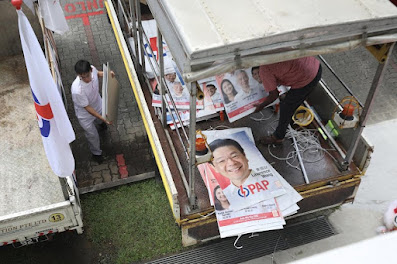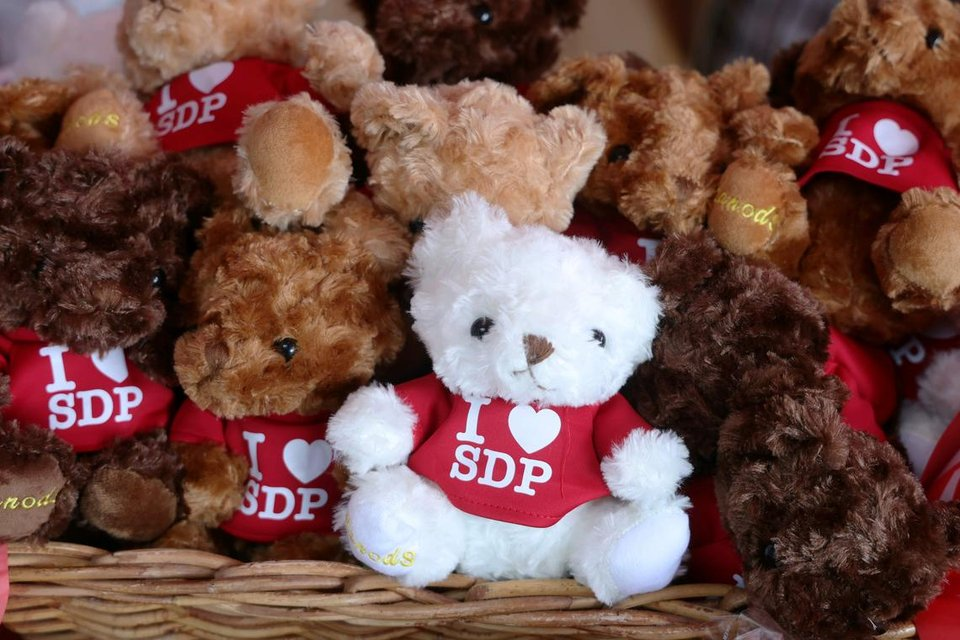How GE2025 candidates are giving their campaign leftovers a second life
 |
Physical advertising materials, like posters and flags, traditionally make up the biggest costs incurred during the election season. PHOTO: ST FILE |
SINGAPORE - With the 2025 General Election now over, several political parties and candidates say they are reducing wastage of their campaign materials by reusing, recycling and even selling some of them.
Those who are selling their physical advertising materials like posters told The Straits Times that they are doing so to raise funds to cover the cost of the campaign, or to donate to charity.
On May 28, the Elections Department (ELD) released preliminary data showing that the average election spending per candidate worked out to be $25,285.
The records showed that the five members of the PAP’s Marine Parade-Braddell Heights team, which enjoyed Singapore’s first walkover since 2011, were the top spenders among 35 candidates who have declared their expenses so far.
Non-online election advertising was the slate’s largest expense, accounting for about 60 per cent of $388,756 spent by the candidates.
Physical advertising materials like posters and flags, which are grouped under non-online election advertising in ELD data, traditionally
incurred during the election season.However, there are no official figures for how much of the materials wind up in the landfill once these campaigns end.
A PAP spokeswoman told ST that the party sorted its election paraphernalia into recyclable and non-recyclable materials, and disposed of them properly.
She said: “Our campaigning materials are not for sale or auction.”
Some items like corrugated parts may be repurposed by printers for other uses, such as cardboard standees, she added.
The spokeswoman said the party also reuses some materials produced before the 2025 General Election, like banners with PAP logos.
 |
PAP volunteers and workers keeping PAP posters featuring Prime Minister Lawrence Wong and elected candidates in Ang Mo Kio GRC on May 4. ST PHOTO: TARYN NG |
The Singapore Democratic Party (SDP) and Singapore Democratic Alliance (SDA) said they recycle some of their campaign materials.
SDA chief Desmond Lim said the party has used biodegradable materials since 2020, and raised $8,000 through sales of roadside posters in 2025, up from about $5,000 after the previous general election.
The proceeds and another $8,000 from Mr Lim’s pocket were donated to The Straits Times School Pocket Money Fund to help children and youth from low-income families with school-related expenses.
 |
Posters of SDA Pasir Ris-Changi GRC candidates on display near Tampines Meridian Junior College on April 28.
ST PHOTO: GIN TAY |
Mr Lim added: “This initiative isn’t just a practice; it embodies our commitment to reducing waste and championing sustainability within our community. We want to create a positive impact not only for our supporters in Pasir Ris-Changi GRC, but also for all Singaporeans.”
Meanwhile, an SDP spokesperson said its leftover campaign material is recycled or used for fund-raising purposes. By June 1, the party had sold about 9 per cent of an estimated 450 roadside posters set aside for fund raising.
As for its merchandise such as umbrellas and stuffed toys, the remaining stock has been stored at the party’s headquarters for future use.
A People’s Power Party spokeswoman said its campaign materials have been distributed or sold to its volunteers and supporters to partially offset expenses.
 |
SDP bear plushies on sale during an SDP lunchtime rally at the promenade next to UOB Plaza on April 29.
ST PHOTO: KEVIN LIM |
The independent candidates who ran during the recent election, Mr Jeremy Tan and Mr Darryl Lo, also said they had sought to make their campaigns environmentally friendly.
Mr Lo, who took 23.52 per cent of the vote at Radin Mas SMC, said he paid more for paper from sustainably managed forests, and printed 13,000 fliers and brochures for roughly the same number of households. Less than 120 copies of each remained after the campaign.
He chose to give away most of the 252 posters printed for the election. Instead of charging fees, supporters were told to donate generously to the Samaritans of Singapore (SOS).
The law graduate who worked in the technology sector said he decided on SOS because of its “profound” work to prevent suicide, which includes manning a 24-hour helpline.
Mr Tan, who garnered 36.18 per cent of the vote share for Mountbatten SMC, said he used leftover plywood from a construction site for his posters. All 200 posters, except for four, have been recycled.
The retired businessman said: “It was cheaper to do things this way, so it wasn’t too challenging.”
He plans to set up a microsite to sell about 1,000 autographed fliers, clappers and t-shirts, with all proceeds to go to organisations like social service agency Care Corner.
ST has also reached out to WP, the only opposition party in Parliament with 12 MPs, and other parties, including the PSP.
The National Library Board’s (NLB) collection of published heritage shows that the WP has, on occasion, donated some campaign materials through the Legal Deposit, which preserves such items.
An NLB spokesperson said it has encouraged political parties and candidates to contribute materials like printed manifestos, fliers, brochures, recordings of campaign speeches, rallies, related websites and social media accounts to the board for preservation.
She said: “In line with the National Library and National Archives of Singapore’s role as a memory institution, materials related to important national milestones in Singapore’s history are collected, documented and preserved.”
Analysts lauded the candidates’ efforts to extend the lifespan of campaign materials, and urged candidates to be more ambitious in their initiatives.
Dr Aidan Wong, who teaches urban studies at Singapore Management University, said the range of steps taken indicates a recognition across the life stages of printed material.
“This movement indicates a greater awareness among political parties that being environmentally sustainable is part of our DNA, and this overall consciousness is gaining good traction.”
James Cook University’s Professor Adrian Kuah, who advises developing countries on minimising waste and maximising resources, pointed out that strategies to reuse and repurpose existing materials are superior to using recycled materials because they reduce further production from raw resources.
“Instead of one-time use, the political party can consider producing posters that can be reused for future events and general elections,” he said.
Dr Wong and Dr Kuah suggested that candidates can take further steps to protect the environment, like introducing zero-waste rallies and hosting more campaign materials online.
During the 2023 Presidential Election, for instance, candidate Ng Kok Song opted to not have physical posters or banners.
Still, party paraphernalia remain a part of political elections, the analysts acknowledged.
Said Dr Wong: “Not only do they make voters aware of the parties and candidates campaigning in their constituency, they also contribute to the overall atmosphere of the campaigning period.”
The practice of selling and giving away party memorabilia dates back to the 1980s, but has become more visible with online platforms like Carousell, according Mr Emyr Uzayr, head of marketing at vintage shop Treasure At Home.
The 21-year-old added: “While I do not see value in the current election materials, you never know how they might be viewed in years to come... What seems unimportant today could become historically significant tomorrow.”


No comments
Share your thoughts! Tell us your name and class for a gift (: